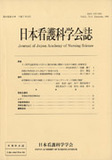Japanese
English
- 販売していません
- Abstract 文献概要
- 参考文献 Reference
要旨
この研究の目的は,濃密なケアを必要とする重症患者(重症ケア患者)について,病院特性別の分布を明らかにすることである.平成3年9月,全国の病院から層化無作為抽出法(抽出確率20%)で調査対象施設を抽出し,病院看護に関する統計調査を郵送法で実施した.病棟情報については,病床規模別にみて偏りが少ない標本が得られるように設計した.全国総病床数の4.2%にあたる情報が得られた.一般病棟の重症ケア患者の割合は総数で5.4%であった.病床規模が大きくなるにつれて上昇し,100床未満の病院の3.0%に比べ,500床以上では7.8%と約2.5倍であった.設置者別では,医育機関の病院が最も高く9.9%,次は公的医療機関の5.8%であった.私的病院は重症ケア患者の割合が低く,個人病院は3.6%,医療法人は4.1%であった.設置者別に分けてみても,病床規模が大きくなるにつれて重症ケア患者の割合は高くなっていた.重症ケア患者の割合を厚生省方式看護度分類のA-I患者の割合と比較したところ齟齬が認められた.ケアニーズは重症度によって規定されるところが大きいので,患者分類法には明瞭な重症度概念が包含される必要がある.
Abstract
The purpose of this study was to examine how the hospital characteristics relate to the proportion of high-acuity patients who require critical and/or intensive care. A survey on hospital nursing was conducted in September of 1991. A 20 pecent random sample, by size of hospital measured in terms of the number of beds, type of ownership and proportion of psychiatric beds, was drawn for all hospitals in Japan for the survey. The survey collected a wide range of information about hospital characteristics as well as characteristics of each ward such as number of beds, case mix and nurse staffing. Usable questionnaires were received from 642 hospitals (34.0%) included in the survey sample, and from 1,281 wards of which the total number of 70,144 beds accouts for 4.2% of all the hospital beds in Japan.
Out of 39,178 patients in 927 general wards, the total number of high-acuity patients were 2,111 patients (5.4%). By the size of hospital, the percentage of high-acuity patients was 3.0% in the category of hospitals with fewer than 100 beds, whereas it was 7.8% in the category of hospitals with 500 or more beds. The percentage of high-acuity patients of university hospitals was the highest (9.9%) among all categories of type of ownership. Generally, non-public hospitals had lower proportion of high-acuity patients than the others; 3.6% of patients of private hospitals and 4.1% of patients of medical care juridical corporation hospitals were high-acuity.
By the patient classification system commonly used in Japan, the patients who are bedridden and require continuous observation by nurses are classified into the group with the greatest nursing needs (so called “A-I” patient). The distribution of “A-I” patients, however, suffered a slippage from the distribution of high-acuity patients in some categories of hospitals classified by their characteristics. It is apprehended that the patient classification system above-mentioned does not reflect nursing care as practiced in the hospitals.
Copyright © 1995, Japan Academy of Nursing Science. All rights reserved.


